Nikon AF-S Nikkor 50mm 1: 1.4G SWM (abbreviated Nikon 50 / 1.4G) is one of Nikon's fastest autofocus lenses. It's classic half a ruble (a lens with a focal length of 50 mm), which is suitable for a huge number of photo tasks, in particular, such a lens can be shot in low light, used as a standard fixed lens on Nikon FX cameras, the lens is suitable for portrait and artistic shooting. With huge aperture F / 1.4 you can create and enjoy the result.
All Nikon 50-58 / 1.4 / 1.2 autofocus lenses
- Nikon 50mm 1: 1.4 AF Nikkor (first version, MK I) - the lens was produced only in Japan from 1986 to 1991
- Nikon 50mm 1: 1.4 AF Nikkor (second version, MK II, also known as the 'N', or the 'NEW' version) - the lens was only available in Japan from 1991 to 1995
- Nikon 50mm 1: 1.4D AF Nikkor (third version, MKIIIbetter known as 'D'-version) - the lens is available from 1995 to this day. There are two subversions that are no different.
- Nikon 50mm 1: 1.4G AF-S Nikkor SWM (fourth version, MKIVbetter known as 'G' version) - the lens is only available in China from 2008 to this day.
- Nikon N AF-S Nikkor 58mm 1: 1.4G Nano Crystal Coat SWM Aspherical (version better known as'58/1.4') - the lens is only available in Japan from 2013 to this day.
- Nikon Nikkor Z 58mm 1: 0.95 S Noct - The lens is available from 2019 to this day. Premium Lens for Mirrorless Cameras Nikon Z... It does not have automatic focus, but has a record aperture. Complex optical design with 17 elements in 10 groups, with 4 ED elements and 3 aspherical elements.
- Nikon Nikkor Z 50 / 1.2 S - The lens has been produced from 2020 to the present day. Professional S-line lens for mirrorless cameras Nikon Z... Complex optical design with 17 elements in 15 groups, with 2 ED elements and 3 aspherical elements
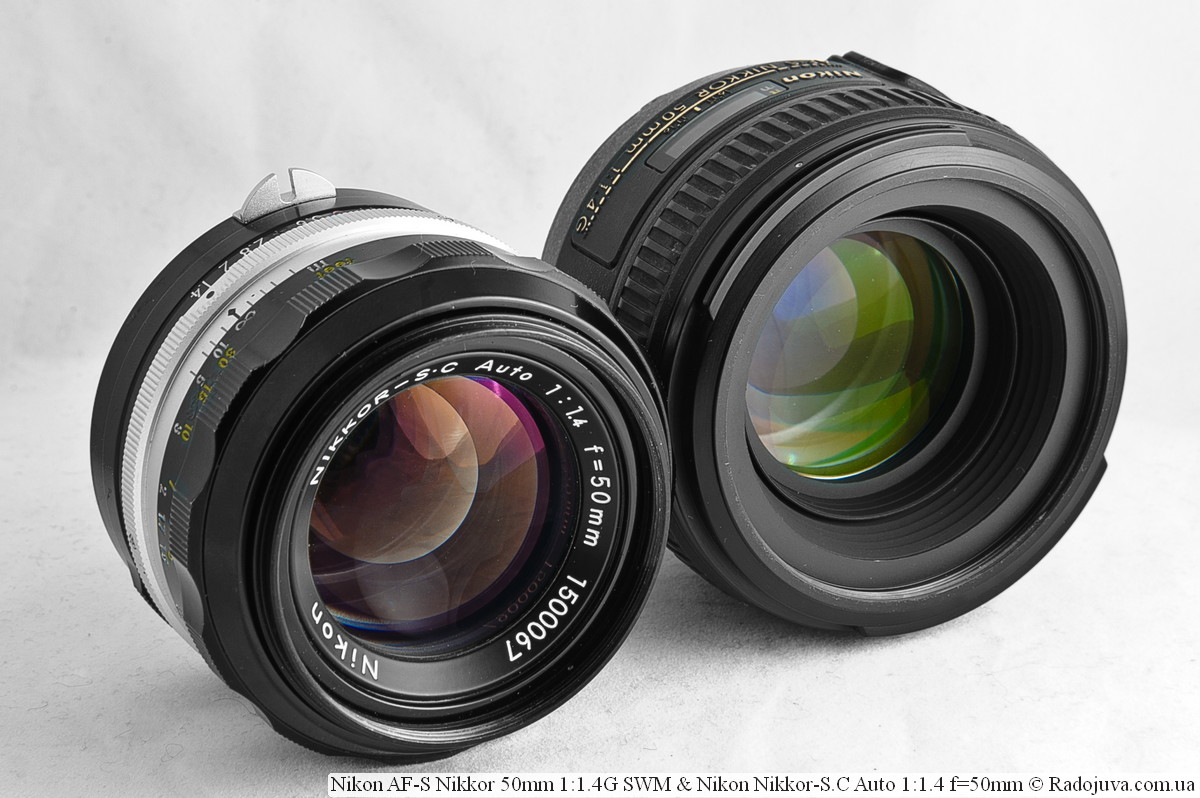
Nikon Nikkor-SC Auto 1: 1.4 f = 50mm and Nikon AF-S Nikkor 50mm 1: 1.4G SWM
Main technical characteristics of Nikon AF-S Nikkor 50mm 1: 1.4G SWM:
| Review Instance Name | Nikon AF-S Nikkor 50mm 1: 1.4G SWM 309536 |
| Basic properties |
|
| Front Filter Diameter | 58 mm, plastic thread for filters |
| Focal length | 50 mm, EGF for Nikon DX cameras is 75 mm, EGF for Nikon CX cameras is 135 mm |
| Zoom ratio | 1 X (this is a fixed lens, it does not have a zoom) |
| Designed by | for digital and film cameras |
| Number of aperture blades | 9 pieces, petals rounded |
| Tags | focusing distance in meters and feet, depth of field tags for F / 11 and F / 16 values, bayonet mount tag and lens hood attachment / fixation |
| Diaphragm | F / 1.4 to F / 16, without aperture ring. |
| MDF | 0.45 m, maximum magnification ratio 1: 6.7 |
| The weight | 280 g |
| Optical design | 8 elements in 7 groups. The lens does not use special optical elements in its design.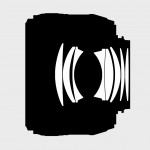 The image of the circuit is clickable. The image of the circuit is clickable. |
| Lens hood | Replaceable Nikon HB-47 plastic lens hood, lenses use the same lens hood Nikon AF-S Nikkor 50mm 1: 1.8G SWM Aspherical and Nikon AF-S Nikkor 50mm 1: 1.8G SWM Aspherical Special Edition |
| Manufacturer country | MADE IN CHINA |
| Period | From September 2008 -> |
| Instruction | View -> |
| Price |
The Nikon 50 / 1.4G lens will work great on any Nikon DSLR camera. Among fifty brothersthis Nikon 50 / 1.4G is the best. At one time, he became a replacement for his older brother Nikon 50mm f / 1.4D AF Nikkor... In fact, the Nikon 50 / 1.4G was introduced back in 2008, and I think that soon we will see a fifty-kopeck piece (50mm lens) from Nikon with more serious performance.
Addition: my prediction came true, and in addition to the 'non-professional' Nikon 50 / 1.4G Nikon has released a 'professional' about fifty kopecks Nikon N AF-S Nikkor 58mm 1: 1.4G SWM... Still, it's a shame that Nikon doesn't have professional fifty dollars. At the same time, Canon has two of them - Canon Lens EF 50mm 1: 1.2 L USM and Canon Lens EF 50mm 1: 1.0 L USM.
Focus on Nikon 50 / 1.4G
The Nikon 50 / 1.4G lens will focus on any modern DSLR camera. If you found your camera in genealogy nameplatethen you can rest assured that the Nikon 50 / 1.4G will work great with it. The Nikon 50 / 1.4G has a built-in focusing motor, as indicated by the AF-S designation. When focusing, the lens practically does not make noise, a special Nikon SWM (Silent Wave Motor) ultrasonic motor helps it. After two years of using my Nikon 50mm 1: 1.8D AF Nikkor (MKIII)which makes a lot of noise when focusing, using the new Nikon 50 / 1.4G is a pleasure.
When focusing, the front lens group moves in the middle of the frame of the housing. I can’t say that the lens has internal focus. But when focusing, the lens does not change its size, and the filter is wound on a fixed external part of the lens, which does not rotate when focusing. This type of focusing can also be found in Nikon 50mm f / 1.8G AF-S Nikkor. The minimum focusing distance is 45cm.
In focus mode 'M / A'Automatic focusing with manual focus priority is available. This means that in autofocus mode, the focus can be manually adjusted immediately. The 'M / A' mode is very useful, for example for creating focus trap effect... In 'M' mode, only manual focus is available. The focusing ring is rubberized.
Focus Speed
Nikon 50 / 1.4G one of the lowest fokiroki speeds among all fifty dollars Nikon Nikkor. Focus speed is average. The rest fifty kopecks Nikkon Nikkor, even the oldest Nikon 50mm 1: 1.8 AF Nikkor MKIoutperform the focusing speed of the Nikon 50mm F1.4G. Of course, to say that a low speed will not be right, but I would like a faster reaction of the lens for that kind of money.
Attention! Very often they write that the lens is very fast. This term is applied not so much to the focusing speed, but more to the description of the lens aperture at which shutter is very fast, decreasing the shutter speed. The confusion came from the English Fast Lens (fast "fast" lens).
The focus ring is rubberized, in the active position it rotates as much as 180 degrees. Due to the fact that the lens is quite chubby, such a move of the focusing ring is quite enough for comfortable work with manual focusing. During auto focus, the ring remains stationary. In manual focus mode, when the ring reaches its extreme positions, it does not rest, but continues to rotate, slipping, like on many native Nikon lenses.
There is a window on the lens with a scale for focusing distances and a depth of field scale. My Nikon 50mm F1.4G misses focus very rarely, even on F1.4.
Iris control
The lens does not have an aperture control ring, since it is a G-type lens. This fifty dollars is very large aperture F / 1.4, this allows you to achieve a very small depth of field, reduce shutter speed and without raising ISO. This lens is very simple take off... The lens has a 9-blade diaphragm, which is a good indicator. The petals are rounded and give a nice smooth bokeh without nuts or other artifacts.
Compatible with FX and DX cameras
The lens will work perfectly on Nikon FX full-frame cameras. On Nikon DX cameras, due to crop factor, EGF lens will be 75mm. This allows the Nikon AF-S 50mm F/1.4G to be used as a portrait lens on DX cameras without any problems. Rumor has it that Nikon AF-S 50mm F / 1.4G is the best portrait lens for crop, I personally like mine much more for crop portrait Nikon 85mm F / 1.8D AF Nikkor.
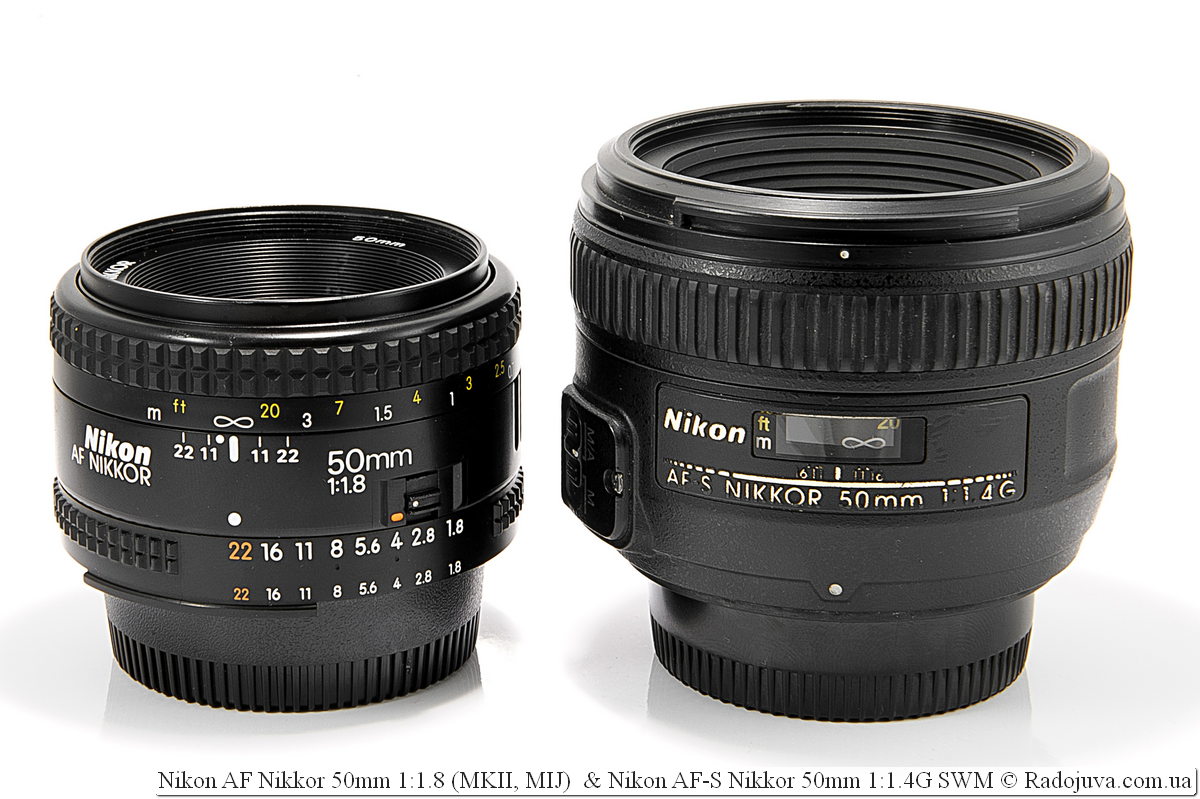
Nikon AF Nikkor 50mm 1: 1.8 (MKII, MIJ version) and Nikon Nikkor 50mm f / 1.4g
Diameter of filter and hood
The lens has a filter diameter of 58 mm. The lens comes with a wonderful hood and pouch bag. The hood can be installed backwards, in this position it is easy to carry on the lens and the hood does not take up extra space in the case.
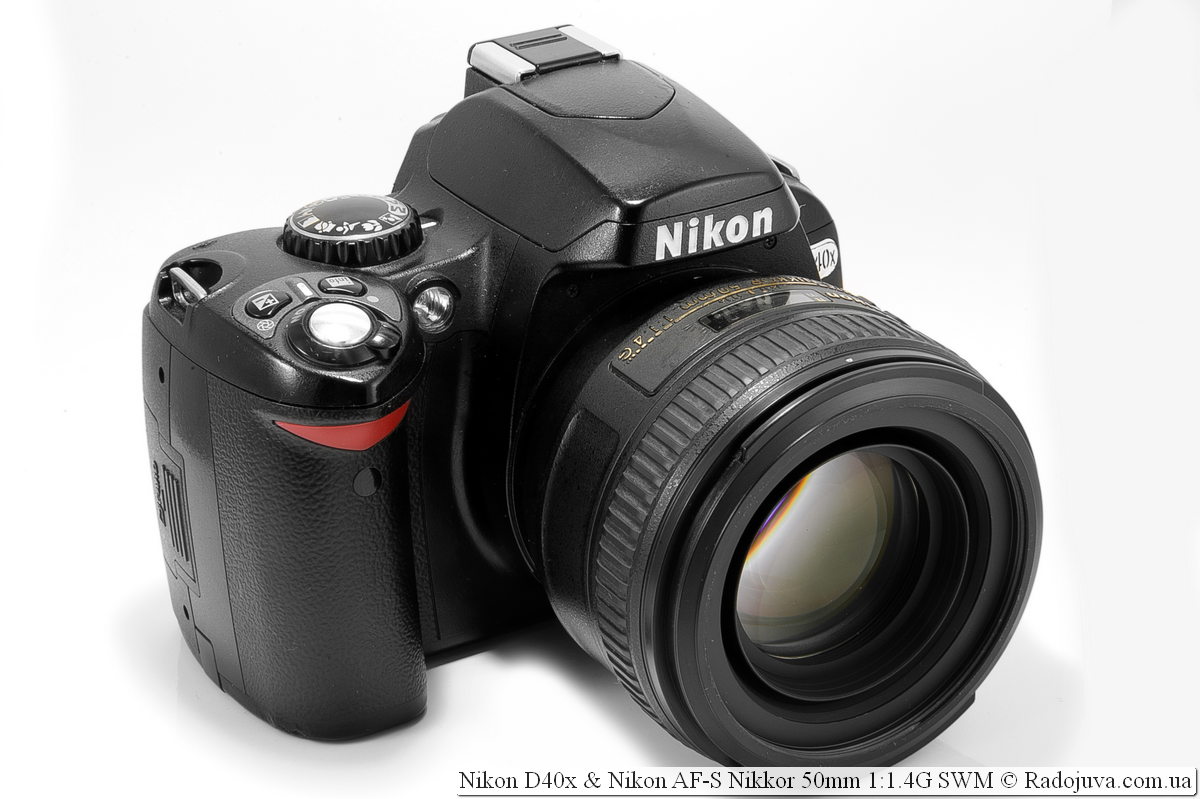
Nikon Nikkor 50mm f / 1.4g on camera Nikon D40x
Nikon 50mm F1.4G Image Quality
The lens, as expected, showed an excellent picture and optical characteristics. The main problem of the Nikon 50mm F1.4G is HA on apertures F1.4-F2.0. The most interesting thing is that HA disappear already at F2.0 - which is a very good indicator. Units have a fully working aperture of F2.0, for example Nikon 50mm F1.2 MF. The lens produces the best image quality at apertures within F2.0-F8.0. Up to F2.0, the lens is inherent HA. After F8.0, diffraction takes effect. About the sharpness: Nikon 50mm F1.4G on F1.4 gives the image is already quite sharp, due to aberrations there is a light software effect. On F1.4, you can make high-quality portraits where strong sharpness of the lens is not always a necessity. Lens gives slightly warm image. The lens provides good contrast. On my cropped camera, vignetting disappears already at F2.8, on F1.4 the vignetting is slightly noticeable. I do not bother with vignetting, it is easy to fix it in the editor. The lens normally tolerates side and back light. A strong drawback in the image of a lens of this class is a slight barrel-shaped distortion (distorting the geometry of the image). Many fifty dollars have much less distortion or do not have it at all. On crop, distortion is barely noticeable. The bokeh of the lens deserves special attention. The lens gives a very nice, even bokeh. Even on closed apertures, discs in the blur zone have a regular round shape. Very funny, but on F1.4, the discs in the blur zone are oval and create twisted bokeh. Generally: high image quality.
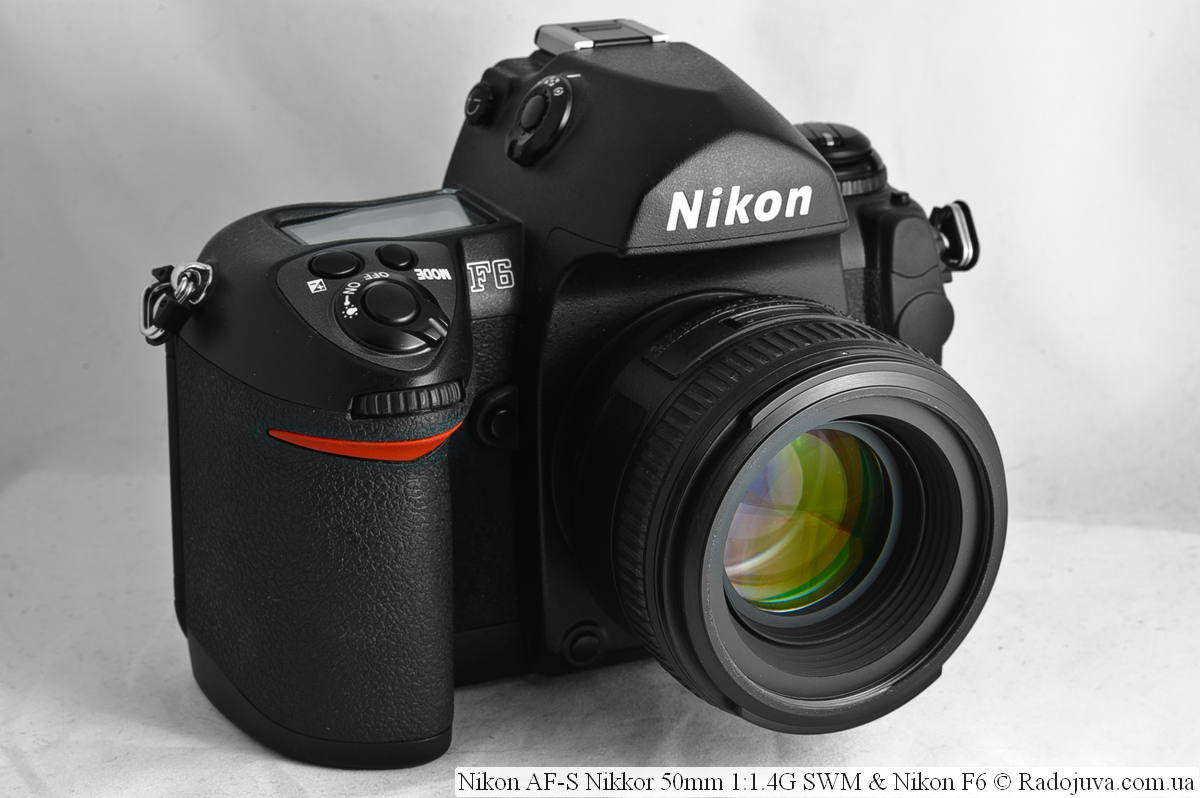
Nikon AF-S Nikkor 50mm 1: 1.4G SWM on a film TOP camera Nikon F6
Sample Photos on Nikon D40 (APS-C, DX)
All photos in the gallery below were taken on Nikon D40. I specifically filmed on Nikon D40to show that even on the simplest DSLR, the lens Nikon 50mm F1.4G works great and with it you can achieve a good result.
Sample Photos on Nikon D80 (APS-C, DX)
All photos in the gallery below were taken on Nikon D80. All photos without treatment... RAW -> JPEG Q80%. Reduced size to 1600 * 1200 and printed data from EXIF.
Sample Photos on Nikon D3200 (APS-C, DX)
All photos in the gallery below were taken on Nikon D3200. All photos without treatment... RAW -> JPEG Q80%. Reduced size to 1600 * 1200 and printed data from EXIF.
RAW source files ('.NEF') can be download from this link (28 files, 350 MB).
More examples of photos can be found on my blog here и here.
Personal experience using
I have a lens Nikon 50mm F1.4G I liked it with my picture (image quality). I often work with optics that only support manual focusing, because the average focusing speed is Nikon 50mm F1.4G for me it doesn’t matter at all. The lens in the hands is quite weighty, but its outer plastic part is felt. And the inscription Made in China is not very credible. I used two years with a tail Nikon 50mm f / 1.8D AF Nikkor after which I switched to Nikon AF-S 50mm 1: 1.4G and I have no regrets about it. In general, if you need a fix after a whale lens, then Nikon 50mm f / 1.8D AF Nikkor or Nikon 50mm f / 1.8G AF-S Nikkor will be the best option. Usually aperture F / 1.4 is rarely required and is quite difficult to work with. F / 1.4 is often taken by professionals who know exactly what they need. My copy was out of order in a light collision from the limousine seat. The focusing motor broke down, the repair cost $ 150, after 3 months the motor broke down again during a long shooting on one of the frames. I sold this lens after repairs. A year later, I bought a new one, then sold it again. Then I bought the same lens again. But somehow this lens did not take root for me.
You can read more information about other autofocus fifty dollars here... In addition, there is also an analogue of Nikon AF-S 50mm 1: 1.4G from a third-party manufacturer - Sigma 50mm 1: 1.4 DG HSM EX.
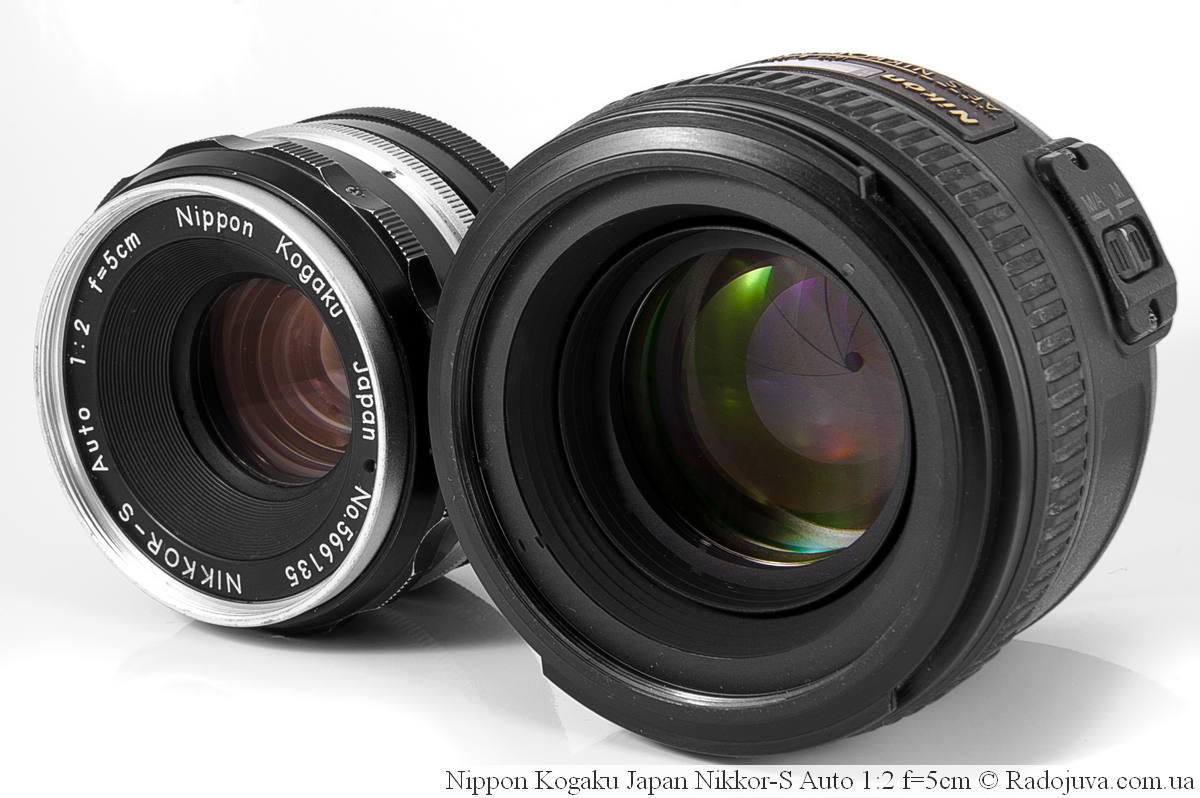
The oldest mirrored fifty dollar - Nippon Kogaku Japan Nikkor-S Auto 1: 2 f = 5cm and TOP Nikon AF-S Nikkor 50mm 1: 1.4G SWM
You can see the real prices for the lens in online stores here, or in the price block below:
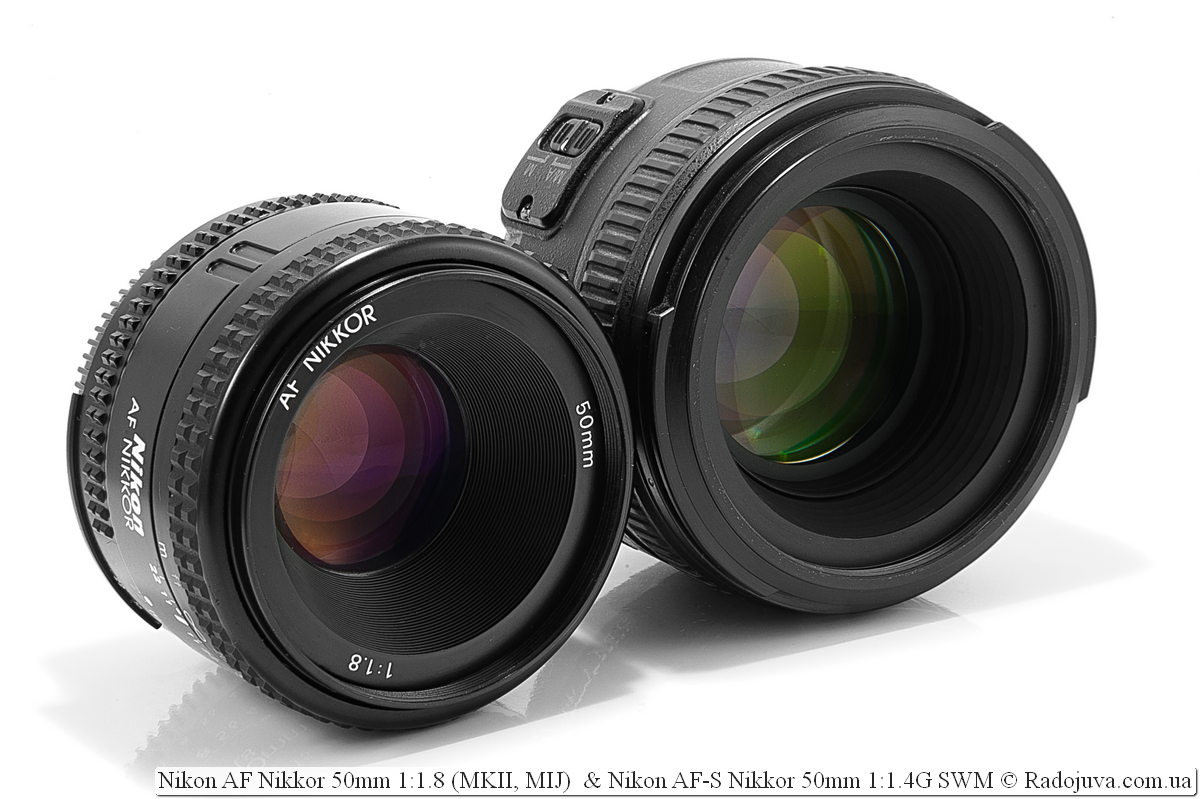
Nikon AF Nikkor 50mm 1: 1.8 (MKII, MIJ version) and Nikon Nikkor 50mm f / 1.4g
Comments on this post do not require registration. Anyone can leave a comment. Many different photographic equipment can be found on AliExpress.
Video review
You can watch the video review here (on my new YouTube channel) or in the box below. Many thanks to Vladimir Morgunov for helping create the video review.
Conclusions:
Nikon 50mm F1.4G - a wonderful lens. Has few shortcomings. It is the best Nikon Nikkor fifty. Recommend.
Material prepared Arkady Shapoval. Training/Consultations | Youtube | Facebook | Instagram | Twitter | Telegram

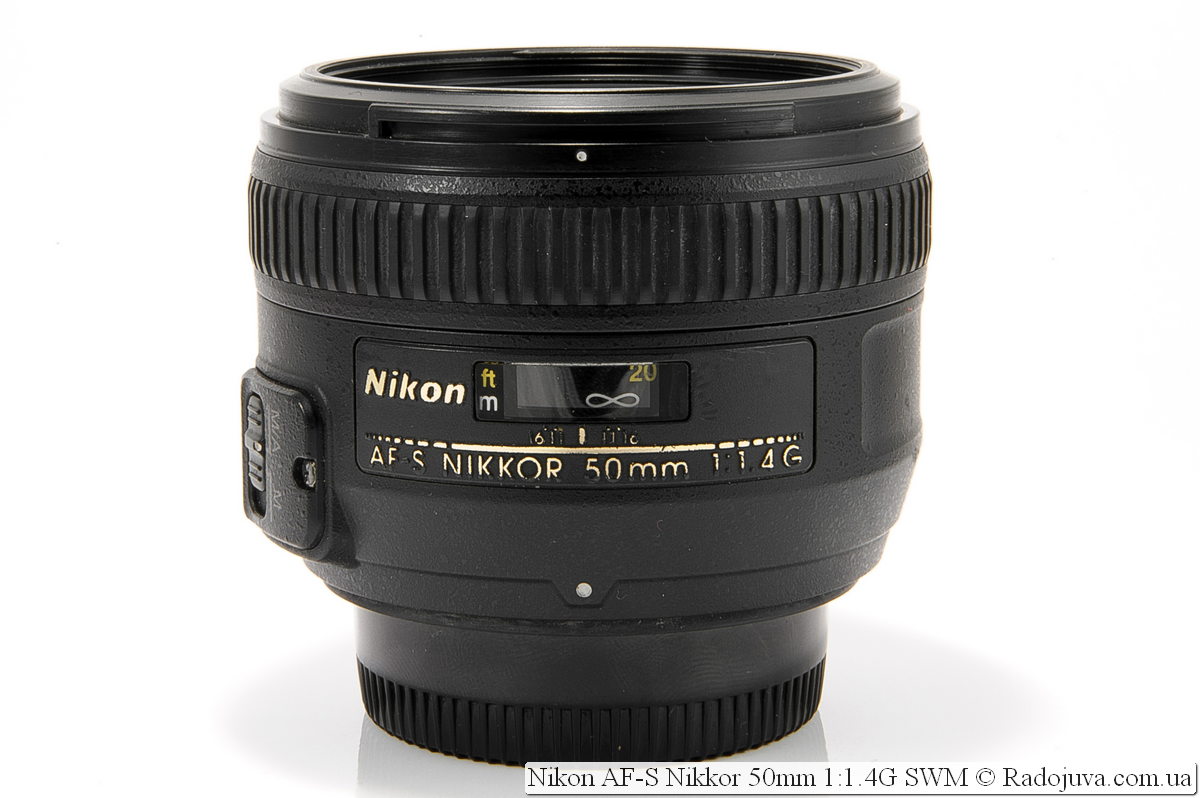
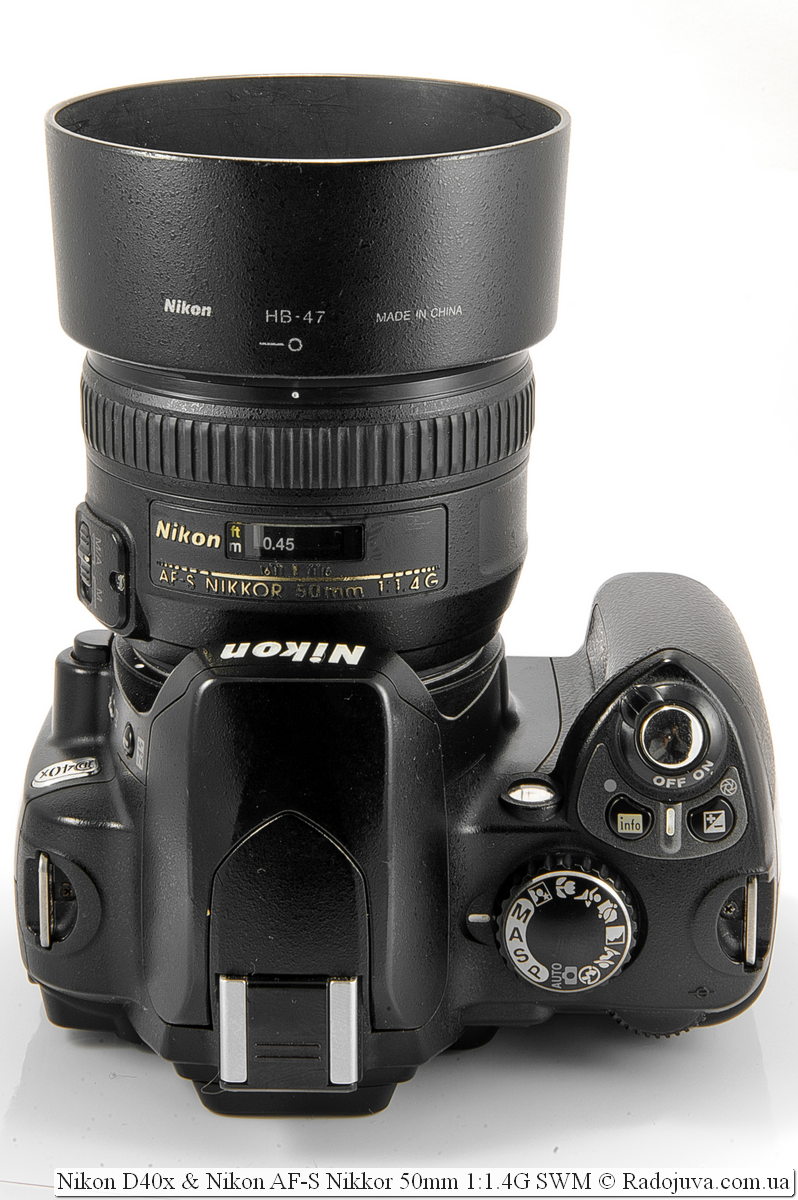
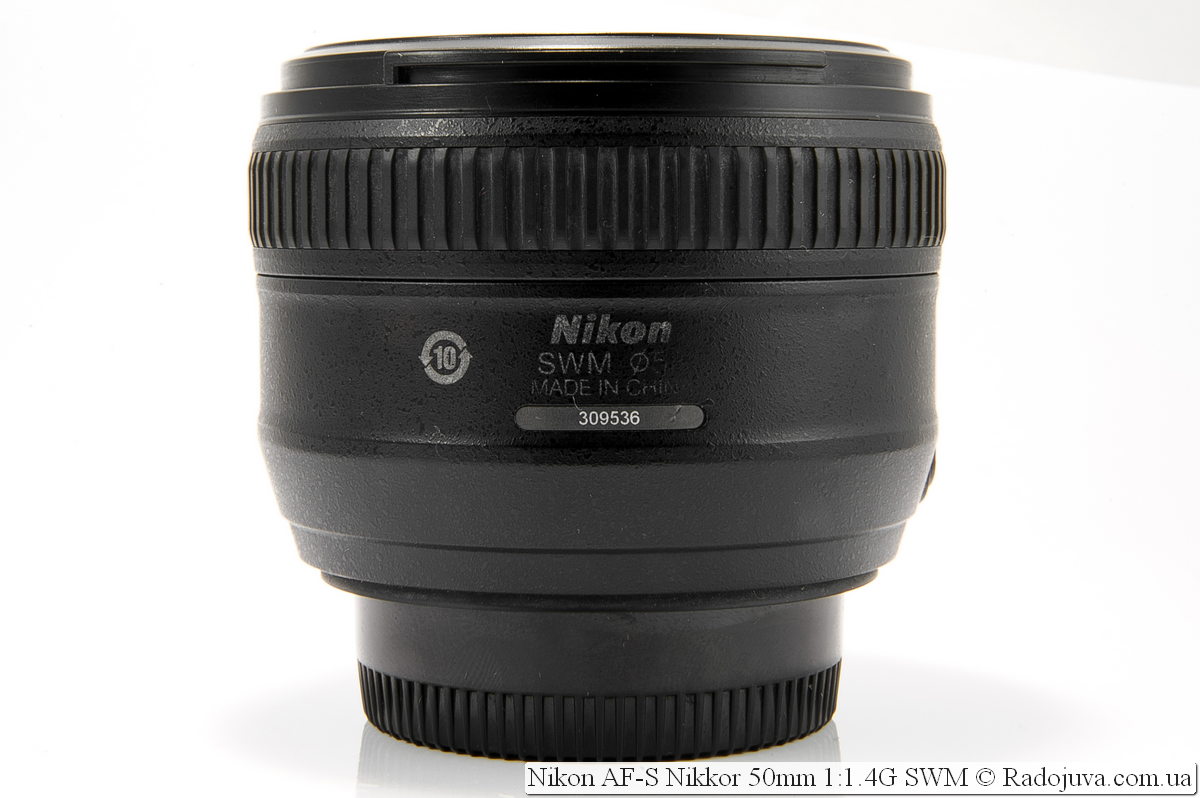
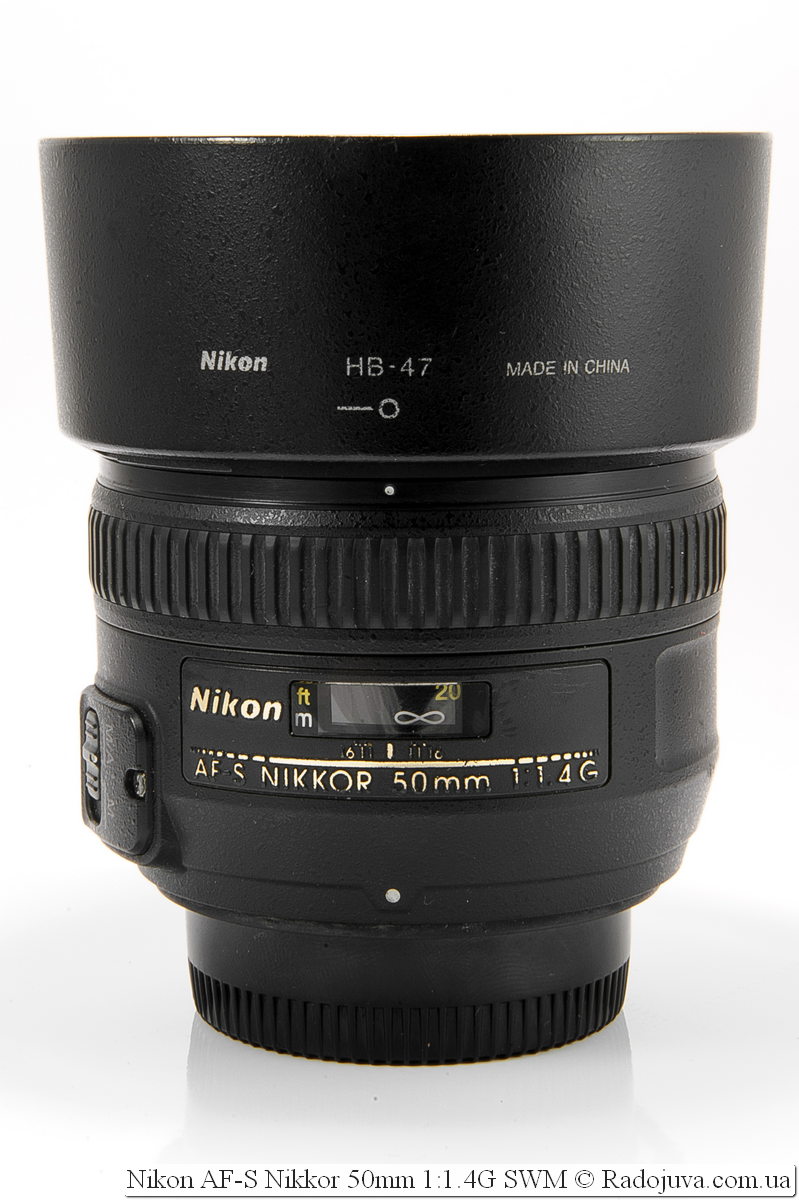
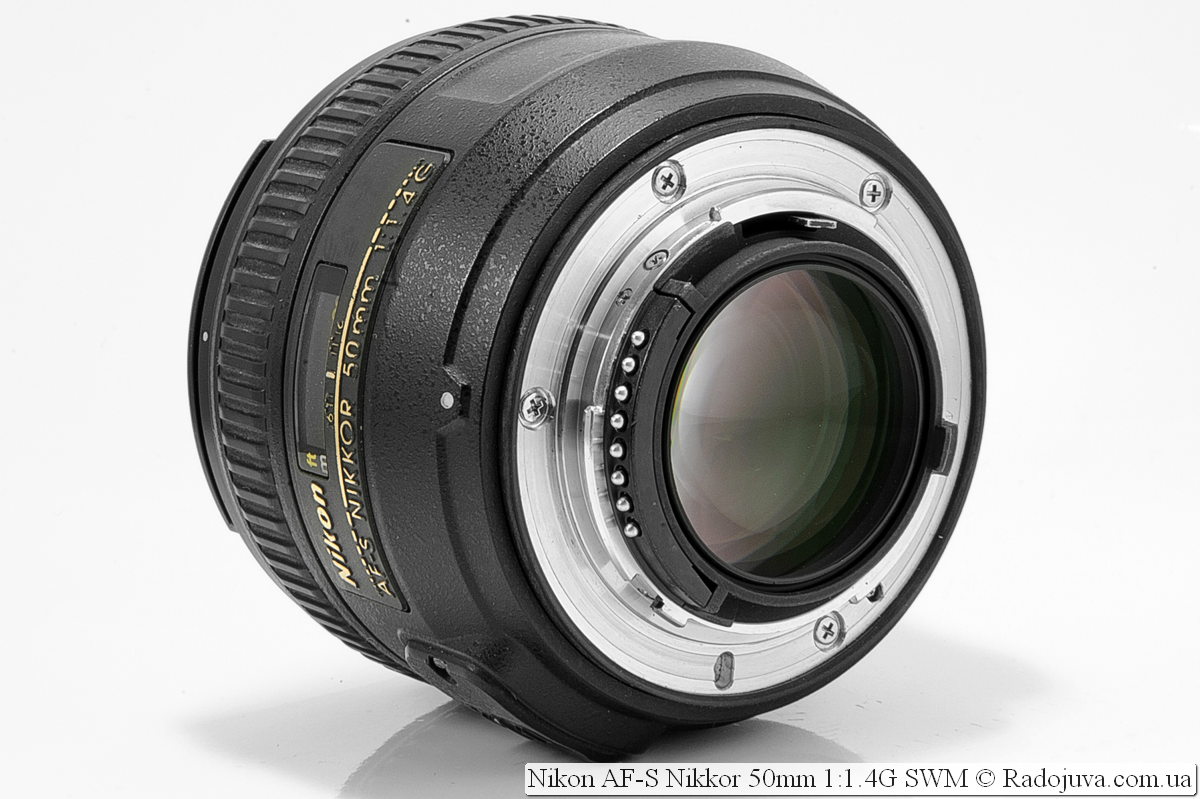
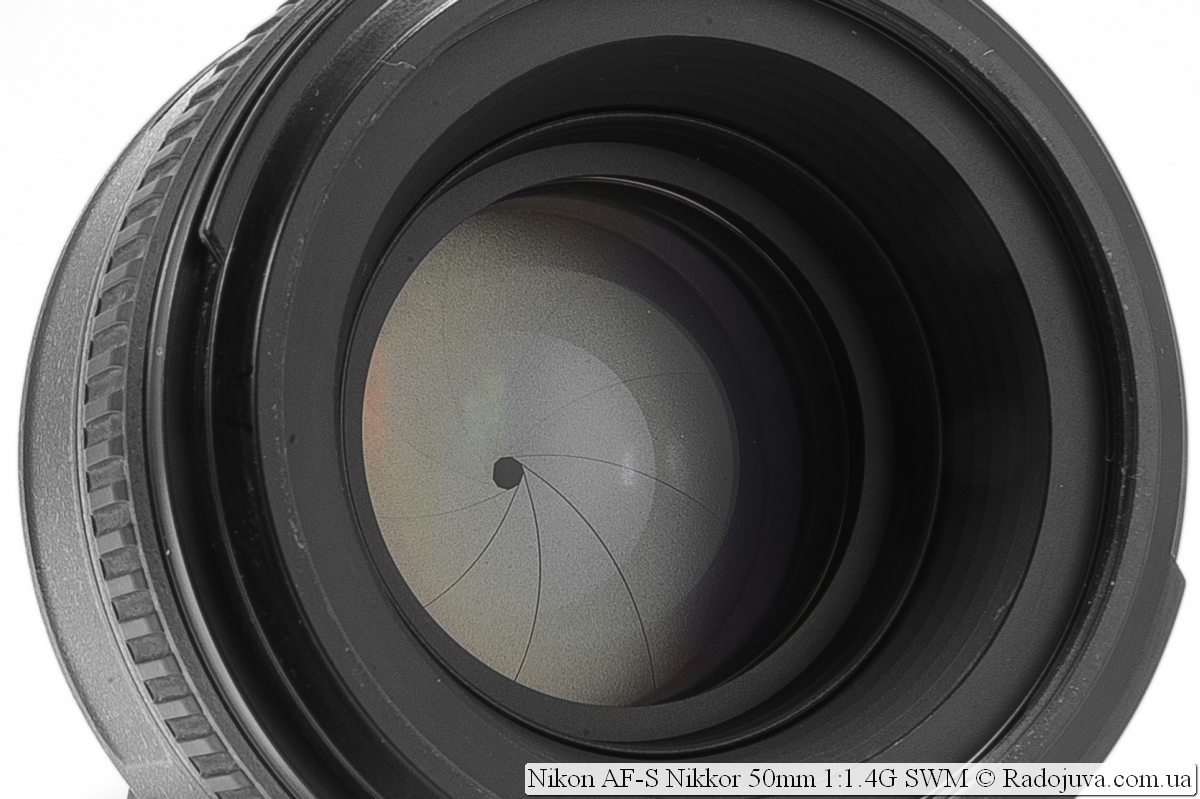
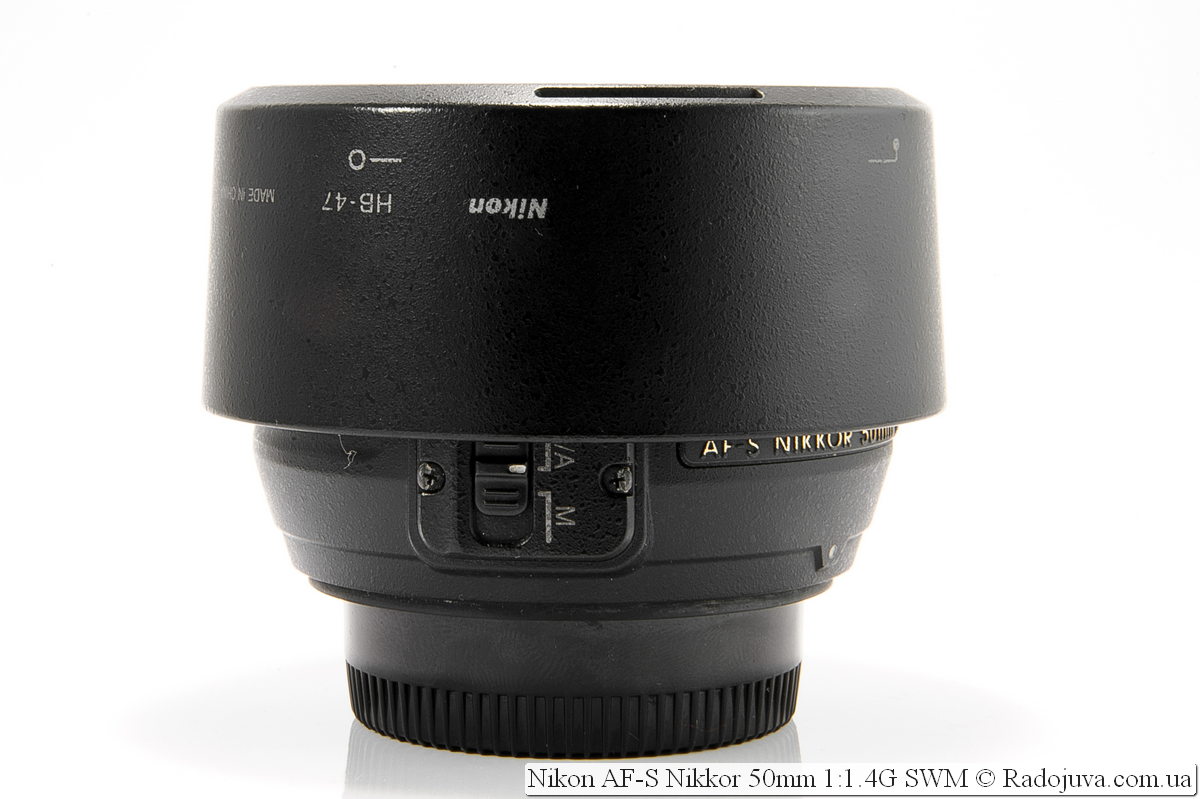


































































That is, there is still a point to change ... There will not be an awl for soap)) I just have an SB-700 flash, but so far I'm just learning to handle it, alas, not very successfully so far, so I prefer it more often without it. Thank you very much for your advice!
Well, 35 1.8 was far from sewn, and 50 1.4g was far from soap. In the reviews on these lenses everything is described in detail, therefore, you can figure it out and make the right choice.
Good afternoon. And if there is 50 / 1.4, does it make sense to take also 35 1.8? Is there any difference between them, for which it makes sense to pay)?
Good afternoon. The difference is in the viewing angles, and, as a result, in the tasks for which this or that lens is intended.
On a full frame, 35mm is conventionally wide, and 50mm is conventionally universal.
On the crop, 35mm conditionally wagon, and 50mm conditional portrait.
I want to ask you what should I take for portrait shooting for my D80th Nikon AF-S Nikkor 50mm 1: 1.4G or Nikon 50mm f / 1.4D AF Nikkor?
Better than the Nikon AF-S Nikkor 50mm 1: 1.4G, it gives a softer picture, which is important for a portrait.
Arkady, I recently acquired the d3100, I am still new to photography, I shoot in automatic mode with a whale lens. I’m thinking of taking the Nikon 50mm F1.4G. Will I feel the difference in the pictures, or the difference in the quality of the photo will not be noticeable?
If you shoot on the machine (green mode), the difference will be little noticeable.
What advice can you give to a novice photographer? What articles to read? what videos to watch? etc.
https://radojuva.com.ua/o-fotografii/, any book on the photograph, then you yourself will understand what you need.
already wanted to buy for my D80 Nikon AF-S Nikkor 50mm 1: 1.4G, but this review was confused http://dvdm.livejournal.com/48315.html
For what purpose is the lens?
portraits and weddings ..
I don’t know whether to take 1,4D or G ..
I use the G version despite the slower focusing speed due to softer pictures and warmer tones.
Good afternoon, Arkady! And how does this lens work on the street? But is it better than 35mm for the holidays?
Works outdoors as shown in the pictures in the overview. If you mean on the street as for reporting - then on the crop - it's bad, on FF with grief in half. 35mm and 50mm are different lenses.
For outdoor portraiture and all sorts of unexpected little moments. Will it be better than 50 with 1.8? On Nikon 5100. Thank you.
It will be better for 1.8D. But the focus speed will lose 1.8G. The choice is always difficult, each lens has its advantages.
Those. advise taking 1.8 instead of 1.4. Got it right?
No, I mean that each version has its own prehistoricities and disadvantages, what to choose is a difficult question, perhaps if it helps you, then I use 1.4G.
Please tell me what is the main difference between Nikonovsky 50 1.4 D and G (meaning the picture)? And is it worth it to overpay for G if the carcass is with a screwdriver. And another question, is there a difference in focusing speed between these lenses?
There are differences in focusing speed. G gives a warmer picture, D gives a colder one with rougher bokeh. Everything is written in the reviews.
And what kind of protective filter do you use with this lens?
One of the easiest marumi mc-uv
Hello! I now have a D3000 kit 18-55, but in the future I plan to upgrade it to D7000. I want to buy such a lens + sb 700 flash. Question: Do I need a kit lens for D7000? Or can I get by with fifty dollars at first as a regular one? over time, I would like to buy another lens for dynamic events, reportage shooting. which one would you recommend? maybe nikor 55 - 200 will do?
Yes it will. I advise 70-300
Arkady, what would you advise an amateur as a staff for Nikon F4 (still just mastering)? Of course, you want good quality and for the automation to work - they have taught digital (Panasonik TZ3).
Sincerely. Valery
I advise fifty fifty 50 and some sort of zoom type 1.4-28
Arkady, please look at the “Focusing speed” there in the sentence “The other three lenses from Nikon 1.8G, 1.8D, 1.4G (?) Outperform Nikon 50mm F1.4G in focusing speed” probably a typo crept in - 1.4 D. Thanks for the interesting materials.
Thanks. Updated.
Hello Arkady. Thanks for your reviews, they help a lot when choosing photo equipment. The question has ripened: on my Nikon 50mm f / 1.8G AF-S, the hyperfocal distance comes from a distance of about 3 meters, the focus ring is generally designed for 1,5 meters, and then infinity. When shooting portraits at full height (about 4 meters to the model), the sharpness (the lens washes) drops significantly on the f / 2.8 crop camera. What about the Nikon 50mm f / 1.4G? What is his hyperfocal distance? Is it possible to clearly consider, for example, model eyelashes when shooting at full height?
It is exactly the same, sharpness is better at the full frame, as the focus distance for the same frame changes.
Thank you for the article. But still I can not decide. I have a D5100 and Nikkor 50mm 1.8D i.e. I'm without autofocus.
The difference in price between 1.8G and 1.4G is also noticeable. I’m shooting a subject and portraits but the speed is not particularly important (the children are calm).
In this article in "Personal Experience" you recommend 1.8G, and this one warns that it is Chinese. But in the article about 1.8G, you write that all the same top-end is 1.4G! Can you describe in a little more detail why such warnings? I still don’t understand which choice are you inclining? :)
Depending on the camera (with or without a motor), you also need to look at the lens. For example, you have D5100 - therefore in this case 1.8G, 1.4G are relevant. The latter gives a good drawing, but has the slowest focusing. Therefore, for fast focus - 1.8G, for beauty and aperture rate 1.4G, for a limited budget - 1.8D, just for aperture - 1.4D. This is written in the review. https://radojuva.com.ua/2012/04/obzor-nikon-af-s-50mm-f-1-4-g/, also, the general lens plate is here - https://radojuva.com.ua/2012/12/all-50mm-lens-nikon-together/
Thanks. The principle is clear and I tend to choose 1.4G, but still how to understand HOW slow is it? I do not shoot a reportage, but all the same I photograph people / children. The concept of speed is also subjective, of course, and until you try it, you won't find out, but all the same, in your opinion, will its speed be enough for studio shooting?
Yes, for the studio you can take it, I myself shoot it in the studio.
Good afternoon, many thanks for the review.
Tell me please. I have 50 1.8D. I shoot mostly plein air in natural light and sometimes in the studio. Do you think it's worth changing to 1.4G? In addition, in the near future they will take Tamron 17-50. And now at a loss: which bunch will still be better 17-50 and 50.14 or 17-50 and 85 1.8
17-50 and 85 1.8 will be better, 50 1.8d can not be changed to 50 1.4
Good Arkady!
I see you are the most experienced. I started choosing a fix. I want spectacular bokeh, because right now 18-105, bokeh has to be pulled through photoshop, even a little fed up. The most popular turned out to be 50 - 1.4, but I was confused by the index G and D. I read it, you wrote that it was in tones, i.e. pace. colors, but this is not a problem RAV corrects everything? Or am I misunderstanding something? For myself, I singled out the following features as the main ones: bokeh, autofocus (of course, it's better to make it faster). Shooting portraits and subjects, mostly outdoors. And if it matters the D90 camera
I am not the most experienced here, but the owner of this site and the author of all articles in Radozhiv. 50 1.4G is the best option for bokeh because of the round aperture.
Thank. Yes, there are 9 petals, which gives a more round hole. then I will consider this option. Only now the prices are somehow too scattered, from 11 to 16)) we will look.
Good evening, Arkady! Thanks for the detailed reviews! My question is: is it possible to use this lens with a film camera (nikon f-601)? or does this require an aperture control ring? I also shoot on a nikon d90 camera and wanted to buy one lens for both cameras. What to choose: type d or type g?
Is it worth it to overpay for a 50 1.4G lens, instead of a 50 1.4D with a screwdriver?
The article says it’s not worth it.
Hi all!
Is this lens suitable for sports events held in gyms?
otherwise I don't see any alternatives ... tele-lenses for this business are too expensive ...
and here, at least with 1/2000 exposure and not very bullying ISO ... it becomes possible to catch the moment ...
or all the same Nikon 50mm f / 1.8G AF-S?
1.8G will most likely be better as it has faster autofocus.
If EGF 75 is a lens, it turns out that it is sharpened on FF, where there is a screwdriver, then why did the AF motor do it? Or is it a mistake and the lens on DX crop and then EGF 50?
Did not AF not AF-S, lenses from a full frame can be used on crop. AF-S is quieter.
I repeat the question: what for goat button accordion? All FFs have a screwdriver, why the motor in the lens? The thought suggests itself that this is glass on crop, and EGF 50, not 75, as stated in the review
You are wrong. This lens is designed for full frame cameras and can be used on Nikon DX cameras as well. More details here - https://radojuva.com.ua/2012/03/nikon-lenses/. In general terms, the built-in motor allows you to avoid unpleasant sound when focusing, which is important for video, also, this is an updated version of more strictly 1.4D, with all the ensuing consequences. And on any lens, the actual physical focal length is indicated, even on DX lenses.
Professional FF cameras Nikon at the time of the release of this lens did not have a video function ...
Nevertheless, this does not change matters.